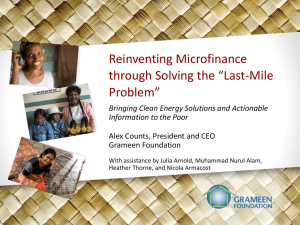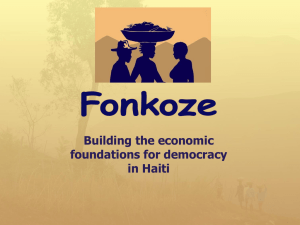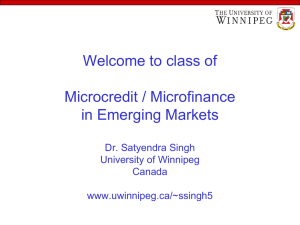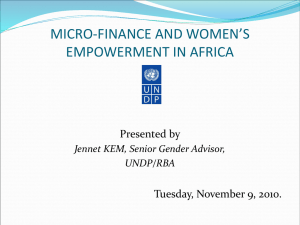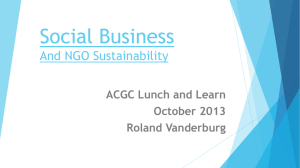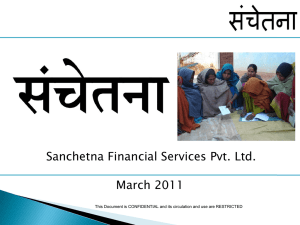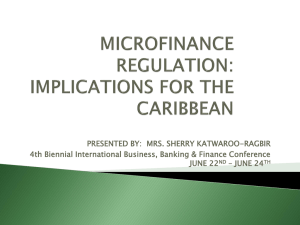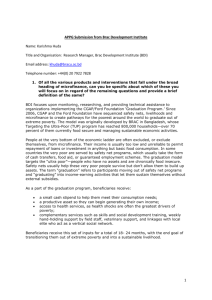Microfinance: Challenges and Opportunities
advertisement
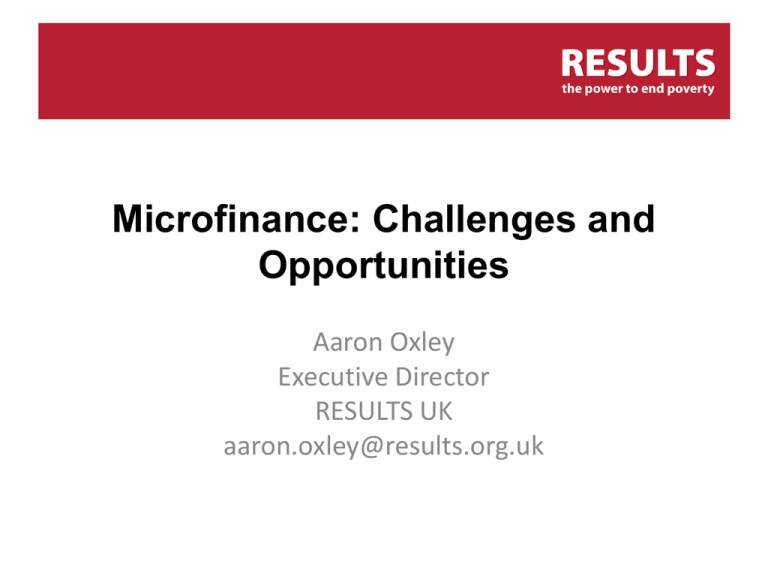
Microfinance: Challenges and Opportunities Aaron Oxley Executive Director RESULTS UK aaron.oxley@results.org.uk Big Picture There are over 10,000 microfinance institutions serving in excess of 150m customers, 100m of them being the poorest families. Global demand is estimated at 500m families, so there is a long way to go. 250 of the largest MFIs are able to access capital on a fully commercial basis from investors like Citibank. Microfinance, if there is any doubt, has become big business. Sustainability vs Profit “No one ever ended poverty by going bankrupt” - John Hatch, FINCA The argument around sustainability is over. Organisations have proven that it is possible to serve the poor successfully while maintaining sustainability. Profit is sometimes a problematic word for the industry. The Compartamos Effect One specific criticism of microfinance becoming big business is that it now provides businesslike rewards to senior management. There are worrying examples of organisations like SKS (India) and Compartamos (Mexico) undergoing IPOs that greatly enrich their staff and put the organisations on a solid trajectory away from pro-development lending. Poverty Alleviation A recent book by Milford Bateman asks the question “Why Doesn’t Microfinance Work?”. In it, he uses the argument that in countries with lots of microfinance, e.g. Bangladesh, poverty persists. There are a lot of points in the book worth debating, but one thing is clear: microfinance alone is not intended to end poverty, it is just one of a set of tools. UK Stakeholder Feedback The APPG initiated a survey with UK stakeholders on what they saw as the key issues facing microfinance today and what would be useful for the APPG to focus on. There was a surprising consensus in the results. Focus on the Poor The universal response was that while the microfinance industry can now proceed purely on a market basis, this is insufficient for using microfinance as a development intervention. Microfinance must be refocused on targeting the poorest, with innovations in product, service, and regulation. We cannot solely rely on the private sector and should be pursuing more PPPs. Focus on the Poor “There is a need for Parliamentary and DFID scrutiny to ensure the government is pressured to protect the interests of the poor and not the banks.” Nowhere was this more clear than in the APPG meeting last year to discuss the development of the joint DFID-World Bank Microfinance Capacity Building Fund for Africa. Bring in Technology Respondents seemed clear that many of the next wave of innovation in serving the poor will be dependant on leveraging technology. Mobile payment systems to extend reach rurally, and connecting MFIs into global payment systems to enable remittance transfers are both critical areas to explore. M-Pesa / Remittances It’s here: 6.5m subscribers in Kenya up from zero in 2007, with many copycat operators springing up around the world. Can MFIs respond to this gamechanging innovation and put it in service of the poorest? Remittances were £272bn in 2009, compared to global ODA of around £80bn in 2007/08. Diversify From Credit Respondents highlighted microsavings and savings-led models as an important area of focus. This matches with field surveys done of customers themselves: microfinance customers want a place to save. Microinsurance is another promising innovation. Three Waves If the first wave of microfinance was microcredit, this is a product offering that is increasingly mature, in plentiful supply, and expanding rapidly from market forces. The second wave of microfinance is microsavings, increasingly becoming mainstreamed into microfinance operations as MFIs and other actors professionalise and transition to formal, regulated institutions. The Third Wave The Third Wave of microfinance rounds out the financial services offering to the poor, and is microinsurance. Very basic products (credit life) have been offered in some form for quite some time. Market research shows huge unmet demand for more complex products, particularly health and crop/agricultural insurance. The Innovative Edge There is a solid trajectory within the industry to move towards savings models, with evidence this is a pro-development shift. If much of the loans and savings are ultimately used as a risk mitigation strategy, however, microinsurance is perhaps the most exciting opportunity of all. Microinsurance Just as with loans and savings, there is a role for the public sector to assist with building the institutional and intellectual infrastructure to support the development of healthy microinsurance markets in health and agriculture. This is particularly true of agricultural microinsurance as it is inherently linked to the climate change adaptation agenda. Conclusions We need to acknowledge the profit motive is firmly embedded in the microfinance industry. We need to win the battle to ensure focus is kept on providing financial services to the poor as a tool to assist them in their escape from poverty. We need to ensure we are creating and supporting innovation around technology and new product lines in microsavings and microinsurance. Feedback? The survey is still open. Go to: http://bit.ly/appgmfsurvey2010




